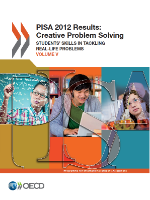PISA 2012 Results: Creative Problem Solving: Students’ skills in tackling real-life problems (Volume V)
|
This fifth volume of PISA 2012 results presents an assessment of student performance in creative problem solving, which measures students’ capacity to respond to non-routine situations in order to achieve their potential as constructive and reflective citizens. It provides the rationale for assessing problem-solving skills and describes performance within and across the 44 countries and economies that took part in the assessment. In addition, the volume highlights the relative strengths and weaknesses of each school system and examines how they are related to individual student characteristics, such as gender, immigrant background and socio-economic status. The volume also explores the role of education in fostering problem-solving skills.
|
View the presentation of the results |
||||||||
Country-specific overviews |
||||||||||
Compare your country using the PISA 2012 results data visualisation
|
||||||||||
Contents (Click titles to read and share) |
||||||||||
Foreword, Acknowledgements, Executive Summary, Reader's Guide, What is PISA? |
||||||||||
Chapter 1 |
Assessing Problem-Solving Skills in PISA 2012 |
|||||||||
|
This chapter introduces the PISA 2012 assessment of problem solving. It provides the rationale for assessing problem-solving competence in PISA, and introduces the innovative features of the 2012 assessment. The framework for the assessment is presented, and sample items are discussed.
|
||||||||||
Chapter 2 |
Student Performance in Problem Solving |
|||||||||
|
This chapter examines student performance in problem solving. It introduces the problem-solving performance scale and proficiency levels, describes performance within and across countries and economies, and reports mean performance levels. It also discusses the relationship between problem-solving performance and performance in mathematics, reading and science. > Download Excel snapshot of student performance in problem solving |
||||||||||
Chapter 3 |
Students' Strengths and Weaknesses in Problem Solving |
|||||||||
|
This chapter provides a nuanced look at student performance in problem solving by focusing on students’ strengths and weaknesses in performing certain types of tasks. The items in the PISA problem-solving assessment are categorised by the nature of the problem (interactive or static items) and by the main cognitive processes involved in solving the problem (exploring and understanding; representing and formulating; planning and executing; monitoring and reflecting). The analysis in this chapter identifies the tasks and skills that students master better than students in other countries do, after taking into account overall differences in performance. |
||||||||||
Chapter 4 |
How Problem-Solving Performance varies within Countries |
|||||||||
|
This chapter looks at differences in problem-solving performance related to education tracks within countries and to students’ gender, socioeconomic status and immigrant background. It also examines students’ behaviours and attitudes related to problem solving, and their familiarity with information and communication technology. In addition, the chapter identifies particular groups of students who perform better in problem solving than expected, given their performance in mathematics, reading and science. |
||||||||||
Chapter 5 |
Implications of the Problem-Solving Assessment for Policy and Practice |
|||||||||
|
In order to succeed in life, students must be able to apply the problem-solving strategies that they learn at school beyond the curricular contexts in which they are usually cast. This chapter discusses the implications of the PISA problem-solving assessment for education policy and practice. |
||||||||||
Annexes |
Technical Background |
|||||||||
Annex A |
Annex A1: Indices from the student, school and parent context questionnaires Annex A2: The PISA target population, the PISA samples and the definition of schools Annex A3: Technical notes on analyses in this volume Annex A4: Quality assurance Annex A5: The problem-solving assessment design Annex A6: Technical note on Brazil |
|||||||||
Annex B |
PISA 2012 Data
Annex B1: Results for countries and economies Annex B2: Results for regions within countries (Excel) Annex B3: List of tables on line: included in Chapter 4 and Annex B2 (Excel)
|
|||||||||
Annex C |
The development and implementation of PISA - a collaborative effort |
|||||||||
> Back to PISA 2012 Results for Volumes I, II, III and IV
Related Documents



